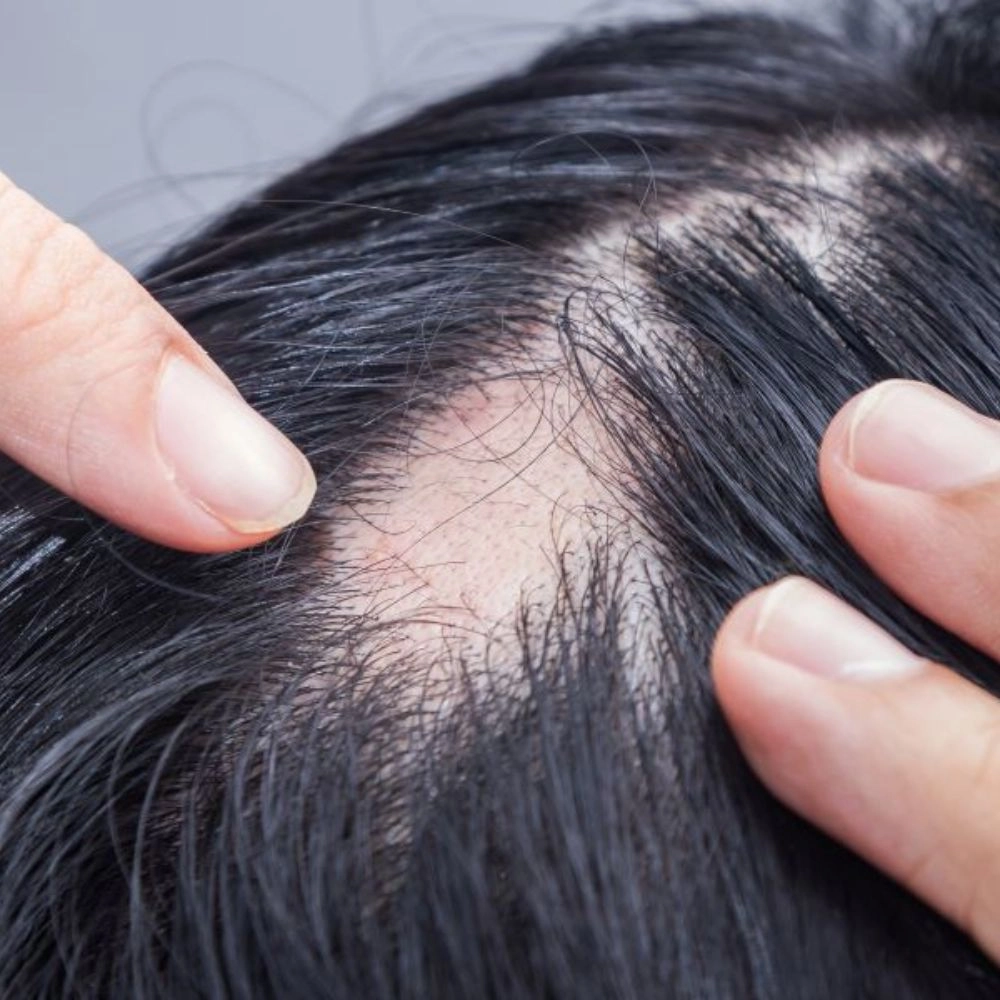Table of content
- Types of BREAST RECONSTRUCTION
- Procedure
- Risks and complications
- Pre-operation preparation
- Post-operative care
- Expected Results and recovery timeline
- Appointments and consultation
- Frequently asked questions
- Meet the team
- Pricing and payment plans
- Medical literature and research
- Support and counseling
- Send a message
ALOPECIA AREATA
INDICATION – BRIEF
Alopecia areata is an autoimmune condition where the body’s immune system mistakenly attacks hair follicles, leading to hair loss in patches. While its primary cause is this autoimmune response, genetics can also predispose individuals to the disease. Non-clinical factors, including significant stress, viral infections, and potential environmental triggers, can exacerbate the condition. However, despite causing hair loss, alopecia areata does not impact overall health, and people with this condition can lead healthy lives. A variety of treatments are available to stimulate hair growth or manage the cosmetic aspects of hair loss.

INDICATION – DEFINITION
Alopecia areata is a condition where hair falls out in small patches, which can be unnoticeable. These patches may connect and then become noticeable, however. This disease develops when the immune system attacks the hair follicles, resulting in hair loss. Sudden hair loss may occur on the scalp, and in some cases the eyebrows, eyelashes, and face, as well as other parts of the body. It can also result in complete baldness (alopecia totalis). But in about 90% of people with the condition, the hair returns within a few years.
Clinical Causal Factors:
- Autoimmune Response: The primary cause of alopecia areata is an autoimmune response where the body’s immune system mistakenly attacks its own hair follicles, perceiving them as a threat. This leads to inflammation and subsequently prevents hair growth.
- Genetics: Alopecia areata is likely to occur in individuals who have a close family member with the disease. Certain genes may increase the likelihood of developing the condition.
Non-Clinical Causal Factors:
- Stress: Significant emotional or physical stress has often been noted as a trigger for alopecia areata. While it’s not a direct cause, it’s a common factor.
- Viral Infections: Some research suggests that specific viral infections can trigger the autoimmune response causing alopecia.
- Environmental Factors: Certain environmental factors may play a role in triggering alopecia areata in individuals who are genetically predisposed to the disease. However, more research is required to establish these links.
It’s important to remember that while hair loss can be distressing, alopecia areata does not affect overall health, and many individuals with the condition continue to lead healthy, active lives. There are also a variety of treatments that can promote hair growth or hide hair loss. The choice of treatment often depends on how much hair has been lost and the individual’s comfort with their appearance.
SYMPTOMS AND DIAGNOSIS
Symptoms
Alopecia Areata primarily manifests as hair loss, which typically appears in small, round patches on the scalp. These patches are usually a few centimeters or less. Other parts of the body can also be affected, and it’s possible to lose hair in the eyebrows, eyelashes, or beard area. Some patients may experience:
- “Exclamation mark” hairs: This refers to short, few hairs that might be seen at the edge of the bald spots, which get narrower at the bottom, like an exclamation point.
- Nail problems: Some people with alopecia areata also have a form of nail pitting, which looks like a pinprick indentation on the surface of the nails.
- Rarely, some people can experience a tingling sensation or mild discomfort in the affected area.
Diagnosis
The diagnosis of alopecia areata is primarily clinical, often based on the characteristic appearance of the hair loss. A dermatologist will examine the pattern of hair loss, check for nail changes and look for any other accompanying signs and symptoms.
In some cases, a scalp biopsy might be necessary, where a small piece of scalp skin is removed and examined under a microscope. It helps to confirm the diagnosis if there’s any doubt.
Blood tests might also be ordered to exclude other conditions that cause hair loss, such as thyroid disease or lupus. If there’s a suspicion of a family history, genetic testing may be recommended.
Alopecia areata can be difficult to predict, with hair growing back and falling out again at any time. However, even though the disease can be emotionally challenging, it does not cause any physical pain or serious health problems. Treatment can help to regrow the hair, but recurrence is common.
Prognosis and Impact

The prognosis and impact of Alopecia Areata can vary greatly from person to person, largely depending on the severity of the condition.
Prognosis
The course of Alopecia Areata is highly unpredictable, and the prognosis varies widely. Some individuals may experience just a few bald patches which regrow hair within a year. In others, the condition can progress to Alopecia Totalis or Alopecia Universalis, which are extensive forms involving the loss of all hair on the scalp or all hair on the entire body, respectively.
Factors that may influence a poorer prognosis include having a family history of the condition, onset at a young age, extensive hair loss, associated autoimmune diseases, and having the form of alopecia that affects the fingernails.
While hair regrowth is common, repeat episodes of hair loss are also typical, and this can lead to complete baldness in some cases. However, even when total hair loss occurs, the possibility of full regrowth remains.
Impact
Although Alopecia Areata doesn’t have any physical health implications beyond hair loss, the psychological and social impacts can be significant. This is especially true in societies where hair is associated with attractiveness or health.
Many people with Alopecia Areata suffer from feelings of embarrassment, frustration, and a decreased quality of life. The condition can lead to social phobia, anxiety, and depression. That’s why psychological support or therapy is often beneficial for people living with the condition.
However, it’s crucial to remember that many individuals with Alopecia Areata lead full, active lives. The disease’s impact varies greatly among individuals, and many people successfully adapt to their condition with time and support. Various treatment options are also available that can help manage the condition, and there’s ongoing research with promising new therapies.
Treatment Options
The selection of treatment can depend on a variety of factors such as the extent of hair loss, patient age, and the patient’s level of comfort with the condition.
Topical Agents: These are usually the first line of treatment. Corticosteroids creams or ointments, Minoxidil (Rogaine), or Anthralin applied to the skin can promote hair growth.
Corticosteroid Injections: For limited Alopecia Areata, steroid injections into the areas of hair loss on the scalp can be an effective treatment method. These injections are typically given by a dermatologist once every four to six weeks.
Oral Treatments: Oral corticosteroids, or other oral medications like Methotrexate or Cyclosporine, can be used in more severe cases or when multiple areas of the body are affected.
Immunotherapy: Topical immunotherapy is another option. This involves provoking an allergic reaction with chemicals applied to the scalp that can help hair grow back.
Light Therapy: This involves a combination of oral medication and exposure to ultraviolet light, and is sometimes used in severe cases.
Wigs and Hairpieces: If treatments aren’t effective, a wig or hairpiece can be used to cover the bald spots, or hair weaving techniques can camouflage hair loss. This can be particularly beneficial for patients experiencing significant hair loss.
Counseling: Given the emotional impact of noticeable hair loss, many people with Alopecia Areata find counseling helpful to cope with the psychological aspect of the condition.
It’s crucial to understand that what works for one person may not work for another, and it may take trial and error to find an effective treatment. Also, regrowth of hair doesn’t necessarily mean the disease won’t recur. Ongoing follow-up with a dermatologist is important to manage the condition effectively.
Risks and Side Effects
Every treatment carries potential risks and side effects, here’s what you should know about the treatments for Alopecia Areata:
Topical Agents: Corticosteroid creams or ointments can cause thinning of the skin and stretch marks where applied. Minoxidil can lead to scalp irritation and occasionally, unwanted hair growth on adjacent areas like the forehead and cheeks. Anthralin can cause skin irritation and stain the skin and clothing.
Corticosteroid Injections: These can cause temporary depressions (dimples) in the skin, which may become permanent with repeated injections. They can also lead to skin color changes. Systemic side effects are rare but can occur with large doses.
Oral Treatments: Oral corticosteroids can have significant side effects, especially when used for long periods, including weight gain, diabetes, osteoporosis, cataract formation, and an increased risk of infection. Methotrexate and Cyclosporine can also have numerous side effects, including liver and kidney damage, and an increased risk of infections. These require careful monitoring with regular blood tests.
Immunotherapy: This can cause a severe rash and swollen lymph nodes, and it’s crucial to avoid sunlight exposure on the treated area.
Light Therapy: Potential side effects include nausea, headache, and fatigue. There’s also a risk of serious skin damage, similar to a severe sunburn, and an increased risk of skin cancer.
Wigs and Hairpieces: While generally safe, some individuals might experience discomfort, itchiness, or skin problems due to the adhesive used for fixing the wig.
Counseling: There are usually no physical side effects associated with counseling. Some people might experience temporary discomfort when discussing their feelings.
Remember, not everyone who takes these treatments will experience side effects. It’s about balancing the potential benefits of treatment against the potential risks. It’s important to discuss these with your healthcare provider to make the best decision for you.
FAQ Section
Alopecia Areata is an autoimmune condition that causes hair to fall out in small patches. It’s due to the immune system attacking the hair follicles.
The exact cause of Alopecia Areata is not known, but it’s believed to be an autoimmune condition where the body’s immune system attacks the hair follicles. Genetic predisposition may play a role, and some triggers like stress or a viral infection may exacerbate the condition.
No, Alopecia Areata is not contagious. It’s an autoimmune condition, and you can’t “catch” it from someone else.
There’s currently no cure for Alopecia Areata, but there are treatments available that can help hair regrow more quickly and may prevent or delay future hair loss.
Treatment options include topical agents like corticosteroids or minoxidil, corticosteroid injections, oral medications, light therapy, or immunotherapy. Sometimes, a wig or hairpiece is a good option for some people. Psychological counseling can also be beneficial due to the emotional impact of the condition.
In many cases, the hair regrows, but Alopecia Areata is highly unpredictable, and it’s different for everyone. Some people may experience more extensive or recurrent hair loss.
No, Alopecia Areata does not cause any physical pain, nor does it lead to any other diseases or health problems. However, it can have psychological effects, as coping with noticeable hair loss can be emotionally challenging.
As the exact cause of Alopecia Areata is not known and it is largely believed to be an autoimmune condition, there’s currently no known way to prevent it.
